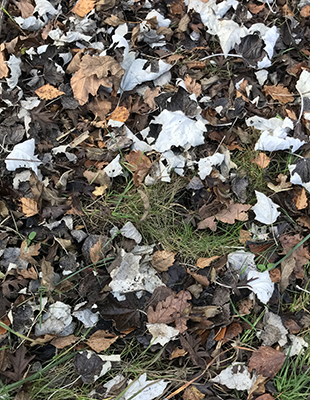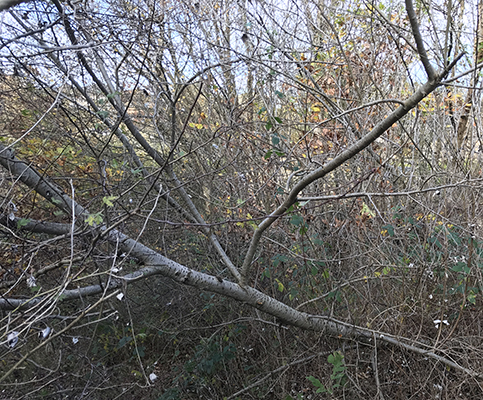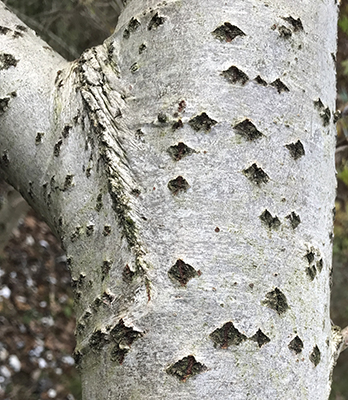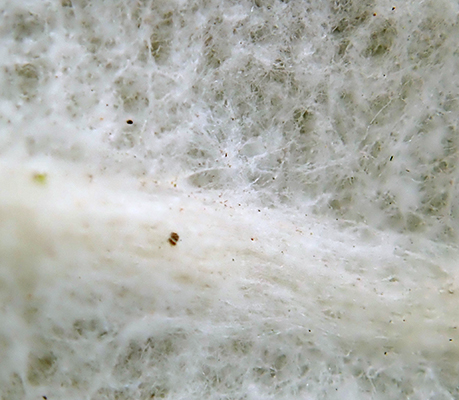With a wide general interest in natural history any flora can prompt closer study—whether wild flowers, ferns, mosses, lichens and trees. I have a passable knowledge of wild flowers, common names at least but an acknowledged weakness is tree ID. The commoner local ones I recognise of course—e.g. horse chestnut, silver birch, oak, sycamore, hawthorn, blackthorn are readily identified—but much beyond that I'm clueless. My lame excuse is that the tree ID books owned tend to show an isolated example of a tree growing in say a large country estate adopting its preferred natural form. However, in local woods this is rarely the case and there's usually a dense cluster of trees all scrambling for light with often atypical growth. Diagnostic features such as flowers and fruits are also often out of reach.
I was on a recent local walk bordering a disused and becoming overgrown recreation ground and noticed very distinctive leaves among the leaf fall. Instead of a typical shade of brown the undersides were a striking greyish white. So I brought a leaf back. Rather than plough through the books to find a match I adopted the lazy naturalist's approach—upload a photo of the leaf underside to Google's image match feature. Bingo, the first link provided the likely identity on a forum where someone else had uploaded the same leaf type and was asking what it was. The contender was the white or silver poplar Populus alba (link to Wikipedia entry).
Reading the book entries on this species it is reported to have distinctive black diamond shaped fissures on the trunk. I had not made a mental note of trunk features so returned with my phone to take images of the trunk. The tree did indeed have these marked features so the ID looks sound. The tree is in a sorry state laying almost flat but with present leaf fall and recall in good leaf earlier in the year it may be just hanging on with an intact enough root system. Alan Mitchell's definitive A Field Guide to the Trees of Britain and Northern Europe (publisher Collins, 1974) notes that it was introduced a long time ago but at an uncertain date. Given it was bordering a former recreation ground in an urban area it may have been planted or possibly a garden escape.
A UK species database the NBN Atlas is being built up but relies on all records to date from many sources being uploaded. On this database the white poplar is not recorded at all in the Huddersfield area in the county of West Yorkshire where I live in northern England. This is incorrect as the The West Yorkshire Plant Atlas Eds. J C Lavin and G T D Wilmore (publishers City of Bradford Metropolitan Council, 1994) has an entry for this species. The species map shows tens of entries for the area although not for the 10 km square where I found a specimen. It is described as 'fairly widespread'. The entry cites Lees (1888) which is The Flora of West Yorkshire by Frederic Arnold Lees. I have an original copy of this splendid book, providing an extensive and thorough treatment of the county's flora at the time. In this entry it is described as 'fairly common' but in my quite widespread local walks from my home I have only found to date this example. The area has of course been extensively urbanised since 1888 resulting in a widespread loss of potential habitats!


The grey-white undersides stand out amongst the typical brown hues of a leaf fall.


This example had fallen down but believe at least some of the root structure is still sound as growing leaves this year and hence the recent leaf fall that attracted attention. The bark has distinctive black diamond fissures.


Left. The downy underside of a leaf under the stereo. Right. A scraped off piece of down under the Zeiss 6.3X objective. The down is a mass of clear twisted flat ribbons ca. 8.5 µm wide when flat. Surprisingly (to me) they showed no evidence of birefringence under crossed polars.
Comments to the author David Walker are welcomed.